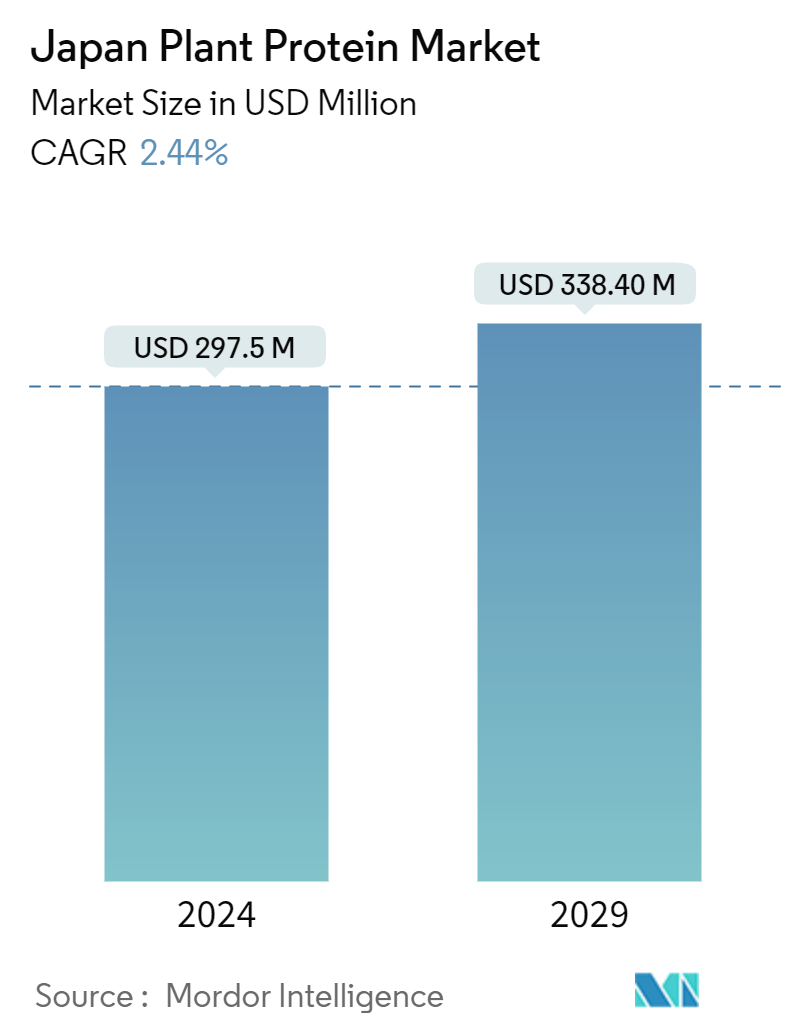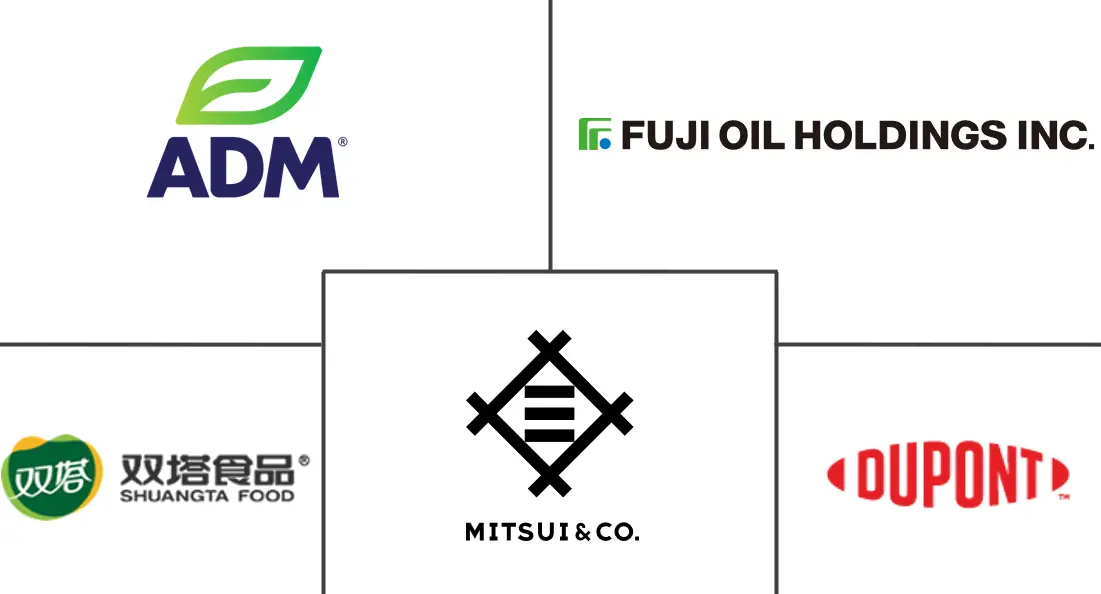Market Size of Japan Plant Protein Industry

| Study Period | 2019 - 2029 |
| Base Year For Estimation | 2023 |
| Market Size (2024) | USD 297.5 Million |
| Market Size (2029) | USD 338.40 Million |
| CAGR (2024 - 2029) | 2.44 % |
| Market Concentration | High |
Major Players
*Disclaimer: Major Players sorted in no particular order |
Japan Plant Protein Market Analysis
The Japan Plant Protein Market size is estimated at USD 297.5 million in 2024, and is expected to reach USD 338.40 million by 2029, growing at a CAGR of 2.44% during the forecast period (2024-2029).
The Japanese plant proteins market has seen significant growth, primarily fueled by shifting consumer preferences toward sustainable, plant-based diets. With growing concerns over health and the environment, many Japanese consumers are turning to plant proteins as alternatives to animal-based ones. Over the years, Japan has consistently produced various plant proteins, leading to market expansion. For example, in 2022, Japan's domestic wheat protein production reached 5.61 thousand tons, as reported by the Japan Plant Protein Food Association (JPPFA). Wheat gluten, a primary product, comes in granular, powdered, and paste forms. While it is used in mock meat, it is more commonly seen as steamed or baked dough blocks in Japanese cuisine. Japan's younger demographic, increasingly focused on sustainability and food trends, presents a key market. Companies must cater to them with affordable, appealing offerings to cement alternative proteins in their diets. Conversely, Japan's aging population, also called the silver generation, shows promise for plant-based proteins, given the challenges many face with digesting animal proteins.
Moreover, government initiatives, such as the Small and Medium-sized Enterprises Innovation Promotion Fund Project, are further propelling the Japanese plant proteins market. Notably, in January 2024, Japan’s Ministry of Agriculture, Forestry and Fisheries allocated approximately USD 27.7 million to two alternative protein startups: Umami United, specializing in plant-based eggs, and IntegriCulture, a cultivated meat biotech firm. These investments aim to bolster the nation's economy, enhance food security, and, consequently, drive market growth. Economic bodies like the Japan External Trade Organization are actively fostering collaborations with alt protein companies, both domestic and international, to bolster the market. Owing to these initiatives and market dynamics, Japan's plant proteins market is poised for continued growth in the coming years.
Japan Plant Protein Industry Segmentation
Plant protein is simply a meaningful food source of protein derived from plants. This group can include pulses, tofu, soya, tempeh, seitan, nuts, seeds, certain grains, and even peas.
The Japanese plant proteins market is segmented by protein type and end user. Based on protein type, the market is segmented into hemp protein, pea protein, potato protein, rice protein, soy protein, wheat protein, and other plant proteins. By end user, the market is segmented into animal feed, personal care and cosmetics, food and beverages, and supplements. Based on food and beverages, the market is further sub-segmented into bakery, beverages, breakfast cereals, condiments/sauces, dairy and dairy alternative products, meat/poultry/seafood and meat alternative products, RTE/RTC food products, and snacks. Based on supplements, the market is further sub-segmented into baby food and infant formula, elderly nutrition and medical nutrition, and sports/performance nutrition.
For each segment, the market size and forecast are offered based on value (USD).
| By Protein Type | |
| Hemp Protein | |
| Pea Protein | |
| Potato Protein | |
| Rice Protein | |
| Soy Protein | |
| Wheat Protein | |
| Other Plant Proteins |
| By End User | |||||||||||
| Animal Feed | |||||||||||
| Personal Care and Cosmetics | |||||||||||
| |||||||||||
|
Japan Plant Protein Market Size Summary
The Japan plant protein market is experiencing significant growth, driven by a shift in consumer preferences towards sustainable and plant-based diets. This trend is particularly evident among younger generations who are more environmentally conscious and open to new food trends. The aging population in Japan also presents a unique opportunity for plant proteins, as they offer easier digestion compared to animal proteins. Government initiatives and economic collaborations are further supporting the growth of this market by promoting alternative proteins as a means to achieve environmental goals. The domestic production of plant proteins, such as wheat and soy, is also on the rise, with soy protein being particularly popular due to its nutritional benefits and cultural acceptance.
The market is characterized by a diverse range of applications and a growing consumer base, including vegans, vegetarians, and those with dietary restrictions. Companies are increasingly investing in research and development to innovate and expand their product offerings in response to the rising demand for plant-based alternatives. The market is fragmented, with key players like Archer Daniels Midland Company, DuPont de Nemours Inc., and Fuji Oil Group leading the charge. Strategic investments and partnerships, such as Roquette's investment in DAIZ Inc., are helping to enhance the texture and nutritional profile of plant-based foods, further driving market growth. The focus on health, sustainability, and innovation continues to shape the dynamics of the Japan plant protein market.
Japan Plant Protein Market Size - Table of Contents
-
1. MARKET DYNAMICS
-
1.1 Drivers
-
1.1.1 Consumer Inclination Toward Protein-rich Food
-
1.1.2 Growing Inclination Toward Plant-based Protein Sources
-
-
1.2 Restraints
-
1.2.1 Allergies Associated with Plant Proteins
-
-
1.3 Porter's Five Forces Analysis
-
1.3.1 Bargaining Power of Suppliers
-
1.3.2 Bargaining Power of Buyers/Consumers
-
1.3.3 Threat of New Entrants
-
1.3.4 Threat of Substitute Products
-
1.3.5 Intensity of Competitive Rivalry
-
-
-
2. Market Segmentation
-
2.1 By Protein Type
-
2.1.1 Hemp Protein
-
2.1.2 Pea Protein
-
2.1.3 Potato Protein
-
2.1.4 Rice Protein
-
2.1.5 Soy Protein
-
2.1.6 Wheat Protein
-
2.1.7 Other Plant Proteins
-
-
2.2 By End User
-
2.2.1 Animal Feed
-
2.2.2 Personal Care and Cosmetics
-
2.2.3 Food and Beverages
-
2.2.3.1 Bakery
-
2.2.3.2 Beverages
-
2.2.3.3 Breakfast Cereals
-
2.2.3.4 Condiments/Sauces
-
2.2.3.5 Confectionery
-
2.2.3.6 Dairy and Dairy Alternative Products
-
2.2.3.7 Meat/Poultry/Seafood and Meat Alternative Products
-
2.2.3.8 RTE/RTC Food Products
-
2.2.3.9 Snacks
-
-
2.2.4 Supplements
-
2.2.4.1 Baby Food and Infant Formula
-
2.2.4.2 Elderly Nutrition and Medical Nutrition
-
2.2.4.3 Sports/Performance Nutrition
-
-
-
Japan Plant Protein Market Size FAQs
How big is the Japan Plant Protein Market?
The Japan Plant Protein Market size is expected to reach USD 297.5 million in 2024 and grow at a CAGR of 2.44% to reach USD 338.40 million by 2029.
What is the current Japan Plant Protein Market size?
In 2024, the Japan Plant Protein Market size is expected to reach USD 297.5 million.

